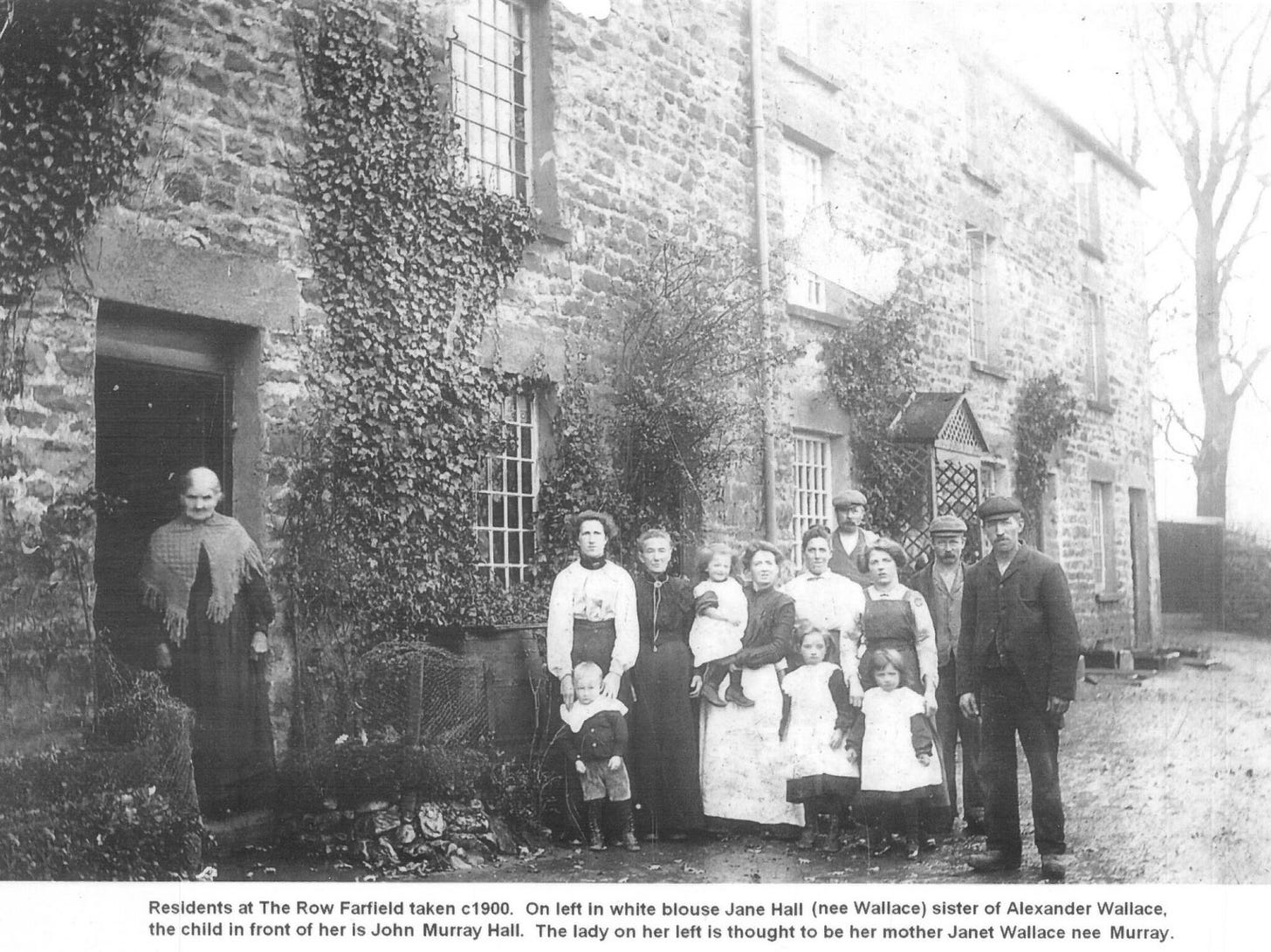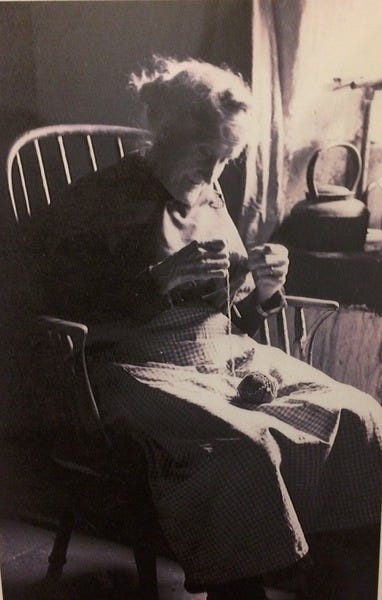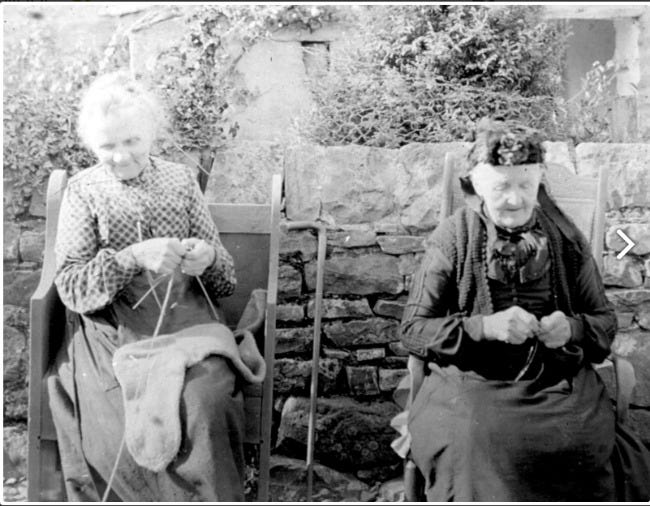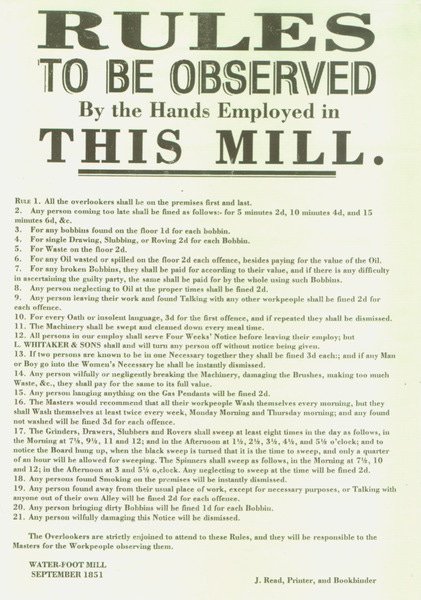On a cold day in February, having cabin fever, my neighbour and I went for a day trip and coincidentally found about the Terrible Knitters of Dent.
The town of Sedburgh, North Yorkshire, is now principally geared to tourism and the exclusive Sedburgh school but in the 19th century, in the year when Victoria acceded to the throne, Farfield Mill was opened, to service the worldwide demand for English woollen items. Today, you can see the workers, as shadowy monochrome figures, in images on the walls of the rooms containing the great looms. The Witney blankets they would have once made lie half made, the warp and weft stood still and waiting.
One image on the wall was of a lady, knitting. She was a terrible knitter of the village of Dent. Going into the mill was a harsh life and there were many ways of losing some or all of your wages (see end of article). It was dangerous for both limbs and lungs, with Brown Lung (a form of pneumoconiosis) carrying off many workers. Even before the mills, people worked at home, knitting or weaving, basketmaking and bodging. Hence, the knitters of Dent. The whole village knitted, and were known for their fair isle work and the speed with which they produced items. As soon as a child was able, they were put to work. The man of the house would wind up the bumps of yarn into three or four strand balls. Each child would work from one strand. If a child knitted slower than the rest they messed up the ball, and messed up the other children. That earned the child a beating, and no dinner. The phrase terrible meant terribly fast, in the parlance of the 18th century.
Two women were studying the pictures of the knitters. There were no pictures of the children.
One said ‘they were probably making a few bob (one bob = one shilling = 5 new pence) out of that’. The other nodded in agreement. ‘oh aye, but they had to, didn’t they? Do you knit?’ They other woman shook her head ‘No, I used to. No one does these days do they? Why would you?’ They laughed and moved off. I felt cut to the quick.
Knitting falls into two camps: there are those who love it, and practice it and have extensive yarn collections and can’t wait to try new techniques and meet other knitters. These people are of all ages, nationalities and levels of income. They know a ton of people who make things. Then there is everyone else, who know no one who knits, but whose granny used to make blankets. They don’t know the difference between knitting and crochet. They will complement your boots whilst you are just yearning for them to notice the sweater on your back, which took you 15 months, and many dark nights of the soul. They will say things like ‘you should sell your stuff on markets’. By markets, they mean sandwiched between the cheese stall and the underwear selections. Seriously, that is never going to happen. They mean well but…
If you read magazines like Country Life, written by people who don’t live in the country by those who can’t afford it, and where there’s never any mud on the dogs on the immaculate sofas, there is always an article about a creative. They will have made something for one of their perfect blonde daughters, and suddenly all their friends would want one too. Next thing, they are in a flood lit studio, wearing floaty clothing and selling to Harvey Nick’s. I lacked the blonde daughters and the obliging friends and will never be tall enough for floaty clothing. Nevertheless, having a side-line always seemed like a good idea. A nice little earner. It has, until recently, never occurred to me that the things I make should not have purpose. How many of you feel like this? My husband, veteran of many of the aforementioned dark nights, offers to take an offending knit (the current one is called the striped bxxxxxxrd), make it have a terrible accident, and we will never speak of it again. ‘Why can’t you do it just for fun?’ he said. Not everything has to be for sale.’
And here was the nub of things. Do women do things ‘just for fun’? I would suggest the answer is no.
Has anyone ever asked someone whose attic is full of a train set, ‘what’s it for?’. Lego is popular with millions of people; people who make things for fun. Has anyone asked someone what their LEGO Super Mario 71426 Piranha Plant (£46.39) is for? Of course they haven’t. It’s a hobby. Hobbies are fun (for the people who do them) except when it comes to what are traditionally thought of as women’s hobbies; knitting, crochet, sewing and I would suggest that is because women have traditionally earned money doing them.
My mother in law was very fond of ‘what’s it for, or (more annoyingly), what is it?’ If I was using my valuable time not working, studying, cleaning and cooking, it was inconceivable that I should frivolous with what remained. I have always had side lines. I have done forensic accounting work, book keeping, garden design, grown herbaceous perennials, sold resin buttons and a few knitting patterns. The things that paid the most, I didn’t enjoy. It never occurred to me to do things for fun.
The problem with wanting to sell what we make is that it has to be the best we can do; or as perfect as possible. Nothing strips the fun out of something faster than being under pressure. You may need to earn money from what you make but I am about to suggest something radical: give yourself time out.
Choose something that you have been wanting to do, and do it. Do it just for you. Do NOT show it on social media or to anyone; this will invite commentary. Do it without redoing it. Do it without it having to be perfect. It doesn’t matter, no one will see. Do you enjoy it? Then continue. Don’t enjoy it? Then stop. No one but you will know. Move on. If you really didn’t like it, donate whatever you produced, or the equipment, and move on. If you keep it, it will use your mental bandwidth and be there, accusing you. You don’t need that.
Summary: you can do something just because you want to; give yourself permission to play. You won’t regret it.
For those who want to play, I will be introducing a really fun, finished in ten minutes, activity which has great latitude for creativity and fun. And it uses up spare yarn. And you can wear it. It will be available for paid subscribers on my Saturday post.
Have a great week
Lily
Links: Farfield Mill
My knitting and crochet patterns
Images: thanks to Sedburgh History Society







This really gave me food for thought! Love that old poster, too.
Thank you for sharing this story and a lovely message. I loved reading it.